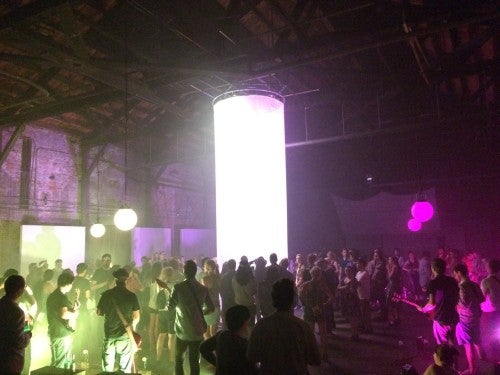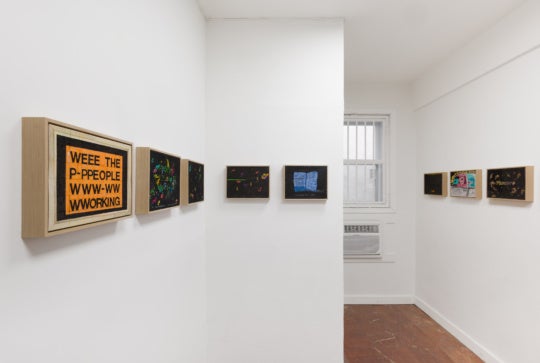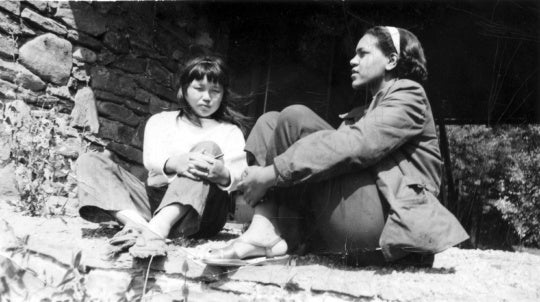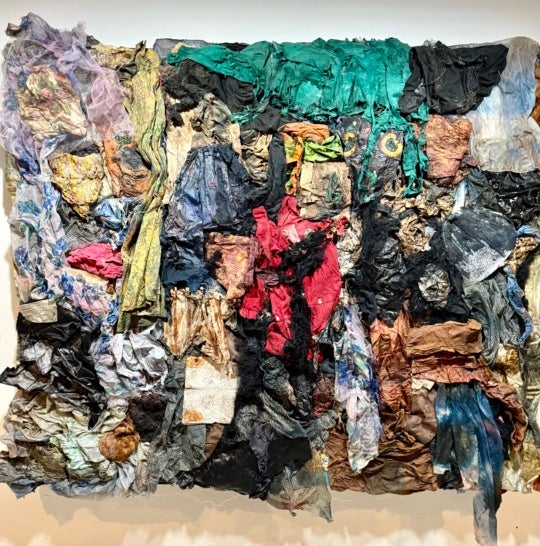
The Color-Tone Drone’s second performance at the Goat Farm turned everyone in attendance into a temporary synesthete, whether or not they’d ever associated royal blue with a B-flat major chord.
For Synaesthesia II, Color-Tone Drone’s Mason Brown and Ian Cone expanded their lineup of volunteer guitarists from 16 to 25. Brown further fleshed out the musical composition, increasing its duration by 15 minutes. Brown and Cone also incorporated new visual elements, including an illuminated column that extended from ceiling to floor at the center of the pentagonal performance area.
The duo’s methods for rendering musical notation graphically allows players to dispense with traditional sheet music. Five orbs of colored light hung from the ceiling, indicating to the five groups of five guitarists which frets to play on their customized and color-coded four-string guitars.
Brown and Cone’s experiments using light to conduct musicians builds upon the tradition of graphic scoring. Graphic scores replace more familiar systems of musical notation by using visual symbols, pictograms, shapes, and colors to guide a musician instead of musical notes and key signatures. Remember the musical staff and the bass and treble clefs from those pesky piano lessons your parents forced you to take? Graphic scores eliminate the need to represent musical ideas within these rigid and codified frameworks, creating new opportunities for experimentation and expression, which composers like John Cage, Morton Feldman, and Cornelius Cardew have all utilized.
Comparisons to Rhys Chatham and Glenn Branca are probably inevitable due to Synaesthesia’s duration and the ensemble’s guitar-centrism. The performance’s originality stems from the questions it asks about the relationships between color and sound, and how the color-tone system reformulates the role of the guitar player, who, in a pop music context, tends to be of central importance.
Here the guitarists were positioned at the periphery of the performance space, surrounding the audience. Individuality, in terms of tonality and texture, was on the whole eschewed (though not entirely excised) in favor of collectivity and homogeneity. Technical skill was not on display. Veteran guitar players stood side-by-side with novice pluckers, like me, who had not slung a guitar over their shoulders in ages. [Disclosure: I have collaborated with Brown on a number of projects.]
But this does not mean that players were not at liberty to exercise choice. Although freedom of expression was highly restricted, each guitarist was forced to make a series of personal decisions: When I strum what rhythmic patterns will I use? What sort of posture should I assume? Do I meet the gaze of the spectators who scrutinize me? If I make a mistake, how do I correct it?
Similarly, the audience was free to decide how to navigate the performance space and which elements to concentrate on. Spectators were informed that, in order to experience the fullest mix of sound and visuals, they should stand at the very center of the space. To hear the musical composition in its totality, it was therefore necessary to give up your freedom of movement.
But this suggestion did not stop audience members from ranging about and interacting with the performers. Synaesthesia II benefitted greatly from the openness of the Goat Farm’s Goodson Yard. Unlike the debut performance at Eyedrum in November 2013, spectators were able to step through the immersive, multisensory environment more easily, which allowed them to create personalized aural/visual blends based on their location and patterns of movement.

There were moments in which the players’ performance choices combined with those of the audience to create spontaneous feedback loops. At one point, a group of five guitarists broke its meditative repose by deploying prototypical rock star moves, waggling the necks of their guitars and executing power kicks. These theatrics attracted the attentions of camera-wielding audience members who in turn egged the performers on.
Any fears I may have harbored that Brown and Cone’s methods would devolve into a form of uninspired roboticism proved groundless. We should not reduce the performance to a version of the popular Guitar Hero video game franchise with high art pretensions. Rather, what was paramount were the ways in which performers and audience members related to the impositions of certain structures and systems that circumscribed but did not eliminate choice.
In this light, their equation of tones with their corresponding colors felt less authoritarian and more like an attempt to introduce a temporary lingua franca that bound together players and audience members through an established visual/sonic vocabulary. The result was a performance art hybrid that stood as a discrete work on its own while creating new possibilities for social engagement and negotiation, especially among a collection of local musicians who might otherwise never have performed together.
Devin M. Brown directs the Atlanta-based cave art collective Speleogen and works on the audiozine ROAM. He is also the human metronome for the experimental music outfit Boating. He thinks headlamps are nifty and his favorite color is forest green.




